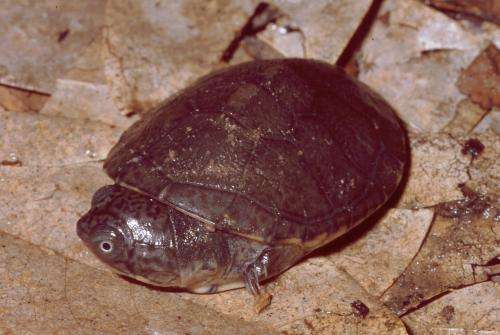The West African mud turtle Pelusios castaneus acquired an “extinct Doppelganger” from the Seychelles due to a scientific error. Credit: Mark-Oliver Rödel
The turtle species Pelusios seychellensis regarded hitherto as extinct never existed. Scientists at the Senckenberg Research Institute in Dresden discovered this based on genetic evidence. The relevant study was published today in the journal PLOS ONE.
Turtles are the vertebrates under the greatest threat. Among the approximately 320 turtle species, the species confined to islands have been especially hard hit – humans have caused the extinction of a whole number of species. One of them – or at least it was thought so – is the Seychelles mud turtle Pelusios seychellensis. Just three specimens were collected at the end of the 19th century; they are still kept at the Natural History Museum in Vienna and the Zoological Museum in Hamburg.
Despite an intensive search for this species, which was declared as "extinct" by the International Union for Conservation of Nature (IUCN), no further specimens have been found since those in the 19th century. "Consequently, it was assumed the species had been exterminated", says Professor Uwe Fritz, director of the Museum of Zoology at the Senckenberg Natural History Collections in Dresden. The Dresden biologist states quite clearly that this is not true. "We have examined the DNA of the original specimen from the museum in Vienna and discovered that these turtles are not a separate species."
The genetic analyses have shown that this supposed Seychellois species is in reality another species, Pelusios castaneus, that is widespread in West Africa. "The species Pelusios seychellensis has therefore never existed", adds Fritz. "In fact, for a long time researchers were amazed that the supposed Seychelles turtles looked so deceptively similar to the West African turtles. But due to the great geographic distance, it was thought this had to be a different species, which is why the assumed Seychelles turtles were also described as a new species in 1906."
Another species classified as native therefore disappears from the list of Seychelles species. Last year, Fritz and his team had already proved that another mud turtle species, Pelusios subniger, was not endemic to the Seychelles but had been introduced by man.
"In the Seychelles there is therefore at most one mud turtle species that could be native. And even with this species we are still uncertain whether it really is endemic", says Fritz. So far, the biologists from Dresden have not been able to explore this possibility due to the incomplete sampling available, however.
"But what is certain even now is that the protection programmes for turtles in the Seychelles will have to be revised, so that truly endemic animal species are protected and the scarce funds available for species protection are put to good use", says Fritz in conclusion.
Journal information: PLoS ONE























